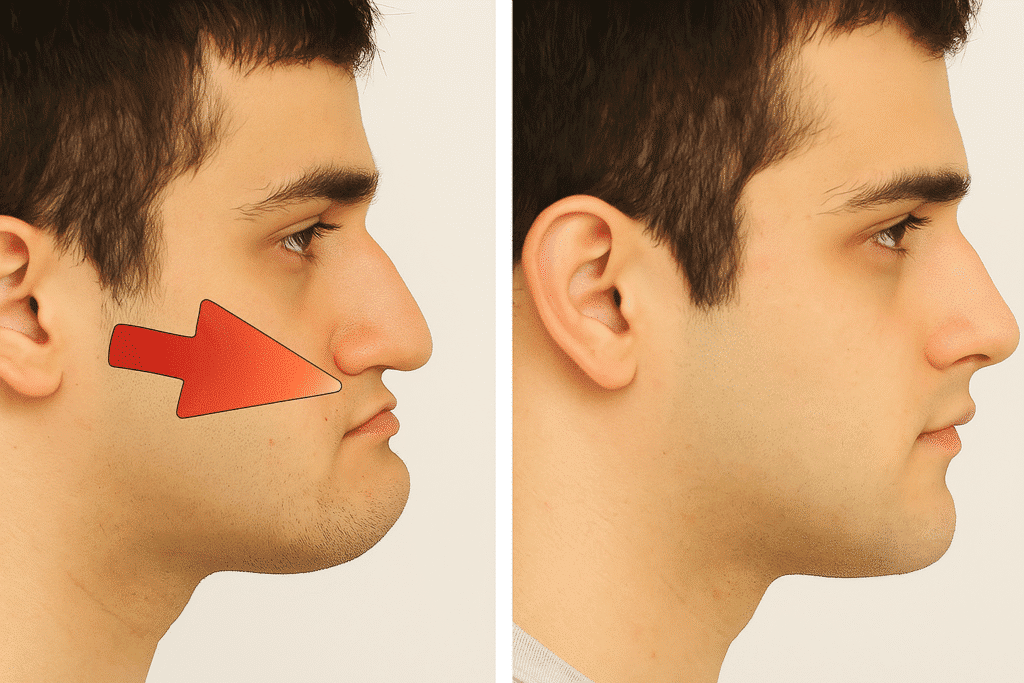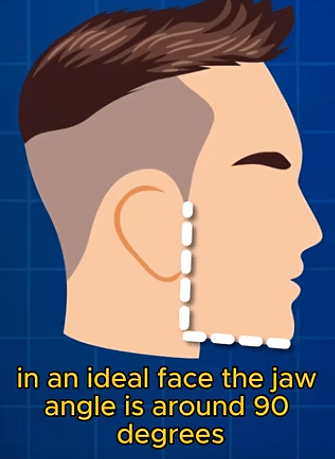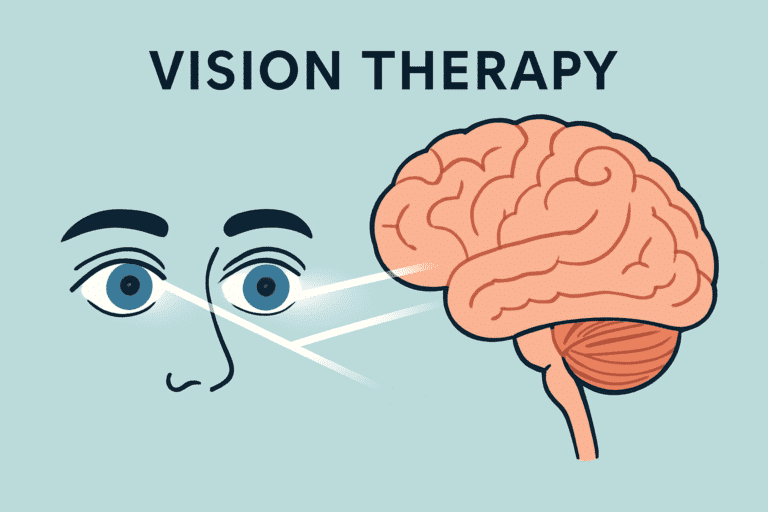Good Maxilla vs Bad Maxilla: 7 Key Differences
The upper jaw, named maxilla, functions as a fundamental structure for your face. Your maxilla controls both facial looks, together with how you breathe and mouth functions, and how well your mouth operates. A properly formed maxilla guarantees functional as well as facial symmetry and dental alignment.
In this guide, I will walk you through detailed ways to assess whether you have a well-developed maxilla.

1. Facial Aesthetics and Symmetry
Your maxilla functions as the main component that shapes your facial visual appearance. Your maxilla helps create facial aesthetic proportion as it achieves a balance between your facial elements.
Here’s how you can assess it:
Midface Projection
- The maxilla should develop properly to allow forward growth which supports the full appearance of your cheekbones and under-eye area.
- This is often associated with a “high cheekbone” look, which is considered aesthetically pleasing.
- A flat or recessive midface area suggests that your maxilla has not developed properly during growth.

Nasolabial Angle
- The angle which measures between your nose and upper lip is known as the nasolabial angle.
- The proper temperature ranges for the maxillary to mandibular area should measure between 90-110 degrees for males and between 100-120 degrees for females.
- A well-developed maxilla supports the base of the nose, creating a harmonious angle. If this angle is too acute or too obtuse, it may suggest maxillary issues.
Facial Balance
- Your maxilla must have an appropriate ratio of alignment to your mandible.
- A maxilla that is set back from the face can provide visual effects that make your lower jaw appear bigger, leading to an equilibrium between facial structures.
- Your profile appearance should be either straight or slightly curved because it demonstrates normal growth of your maxilla.
Under-Eye Support
- Proper maxillary structure offers essential support to the area below the eyes, stopping their appearance from becoming hollow.
- Dark circles accompanied by a lack of under-eye support might indicate insufficient development of your upper jaw.

2. Dental and Occlusal Alignment
The maxilla sets the arrangement of the upper teeth and jaws in their correct positions. The state of dental alignment serves as the main signal of a healthy maxilla.

Proper Bite
- Your upper teeth will match your lower teeth correctly because of a developed maxilla.
- Overjet: A normal overjet occurs when the upper front teeth position 2 to 4 mm above the lower teeth.
- Overbite: The correct vertical relationship between upper and lower teeth presents when the upper front teeth overlap the lower front teeth by 20-30%.
- Eyewitness symptoms of an off-center bite typically signal problems with the maxilla.
Dental Arch Shape
- A proper upper dental arch should display a wide U-shape in its design.
- The V-shaped or narrow dental arch structure produces space deficiencies which trigger dental misplacements.
- A properly developed maxilla makes it possible for all teeth to find their correct positions.
Palate Height
- The surface of your mouth needs to be wide and not to rise above its normal height.
- Medical evidence suggests that both poor maxillary development and breathing problems alongside altered tongue position can result from a narrow or high palate.
3. Nasal Breathing and Airway
Nasal drainage and airway efficiency depend on your maxilla because it serves as the base of your cavity.
Nasal Passages
- A well-developed maxilla supports the nasal cavity, allowing for proper nasal breathing.
- Good maxillary development shows these features:
- No chronic nasal congestion.
- Maxillary issues may be present when you continually experience either nasal congestion or mouth breathing.
- If you frequently experience nasal congestion or mouth breathing, it may indicate maxillary issues.
Nasal Base Support
- The maxilla provides a stable base for your nose.
- A good maxilla prevents a collapsed or pinched nasal appearance.
- If your nasal base appears narrow or unsupported, it could be a sign of poor maxillary development.
Read Also: LASIK & Medicaid: Does It Pay for Vision?
4. Profile and Side View
The maxillary development becomes visible when you look from the side. A properly developed maxilla functions together with others to produce an aesthetically balanced facial appearance.
Facial Profile
- The development of the maxilla helps to produce either straight lines or a convex appearance for your facial structure.
- The retracted position of the maxilla results in facial profile degradation that creates a hollow facial shape with an emphasized chin.
Lip Support
- The maxilla supports your upper lip, preventing it from appearing overly thin or recessed.
- Your lips should rest comfortably together without strain.
- If your upper lip appears thin or unsupported, it may indicate maxillary issues.
Chin Position
- A good maxilla ensures your chin is not overly prominent or recessed relative to your upper jaw.
- Your upper lip appears thin and unsupported whenever your maxillary structure has issues.
5. Functional Indicators
Apart from its appearance, the maxilla serves critical functional purposes because it enables proper chewing abilities and sustainable speech production and supports optimum tongue position.

Chewing and Speech
- When maxilla develops properly it enables smooth bite mechanics together with clear vocal functions.
- The development of your maxilla becomes apparent through hindrances in chewing food along with speech conditions that produce lisps.
Tongue Posture
- The upper part of your tongue needs to rest properly against the roof of your mouth.
- Your tongue positions itself below its natural resting point when the maxilla remains too narrow thus affecting breathing and natural swallowing patterns.
- Proper tongue posture is essential for maintaining airway health and facial development.
6. Signs of Poor Maxillary Development
A recessed maxilla will show itself through specific signs you must observe.
- Flat or Recessed Midface: Lack of forward growth in the cheekbones and under-eye area.
- Crowded or Misaligned Teeth: Insufficient space in the dental arch.
- Chronic Mouth Breathing: Difficulty breathing through the nose.
- Gummy Smile: Excessive exposure of the gums when smiling.
- Long Face Syndrome: Long Face Syndrome occurs when a vertical maxillary excess causes the face to lengthen.
7. Professional Assessment
To evaluate your maxillary development correctly you should seek guidance from a knowledgeable person.
Here’s what you can expect:
Cephalometric X-rays
- Special X-ray procedures enable the assessment of both maxillary position and developmental status.
- Through these diagnostic tests, you can obtain extensive information about the structure of your face together with details about your bones.
Dental Impressions
- A dental impression system determines both the dimensions and form elements of your dental arch structure.
- They help identify issues like crowding or a narrow palate.
Clinical Examination
- A professional will evaluate your breathing, tongue posture, and facial symmetry.
- They may also assess your bite and dental alignment.
Read Also: Pain-Free Laser Eye Surgery? What to Expect
Final Words
Your maxilla acts as the fundamental base of your facial bone arrangement because it controls both beauty aspects and operational capability. You can obtain meaningful information about your maxillary growth by evaluating your midface projection as well as your dental alignment nasal breathing and facial profile.
A maxilla in good health provides essential contributions to both facial appearance and dental health systems and respiratory functionality.







